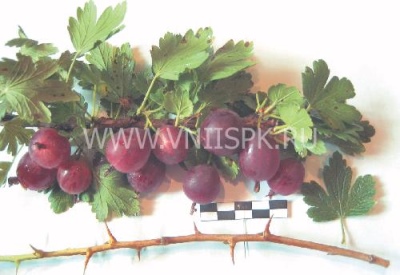
- Authors: K. D. Sergeeva (All-Russian Research Institute of Horticulture named after I.V. Michurin)
- Appeared when crossing: Malachite with a mixture of Northern grape pollen x select spineless seedlings 21-57, 12-59, 13-62 (Gr. Robusta x Date + English yellow + Green bottle + Industry)
- Year of approval: 1986
- Growth type: vigorous
- Description of the bush: compact, medium density crown, medium branching, vertical direction of branches
- Escapes: growing - medium, almost straight, dark green, with a pink top, not pubescent; lignified - medium, light
- Thorniness: strong
- Thorns: single, double and triple, medium, thick, straight, light
- Sheet: large, dark green, matte or low sheen, undisturbed, folded, leathery, concave or wavy
- Spike location: directed downward and located along the entire length of the shoot
Gooseberry Plum belongs to the long-established varieties with a history. It is excellently transported and stored, therefore it is often grown on an industrial scale. Gardeners loved it for its good yield and minimal maintenance.
Breeding history
The author of the culture was the breeder K.D.Sergeeva, an employee of the V.I. Michurin. The new species was bred by a complex crossing of the Malachite variety and a mixture of pollen from Northern grapes with low-thorn selective seedlings 12-59, 21-57 and 13-62, which included Gr. robusta and Date with English Yellow, Bottle Green and Industry. After the work was done, the variety was sent for state variety trials, which began back in 1964. Many years later, in 1986, the Plum was finally included in the State Register, and it was approved for cultivation.
Description of the variety
Plum bush is vigorous, but compact, with medium density. It is not characterized by an abundance of growth of basal shoots. The branches are slightly curved, growing vertically. There are many thorns, directed to the ground, all shoots are completely covered with them, thorns can be light-colored - both single and double, triple.
The foliage is large, matte leaf plates are 5-lobed, the incision is deep, pubescence is absent. The inflorescence can be either one- or two-flowered.
Characteristics of berries
Gooseberries Plum are considered large, the weight of the berries ranges from 4 to 6.5 grams. The shape is an oval, sometimes a wide oval. The color is dark red, after full maturation, the color can be almost black. There is a wax coating. The skin of the berries is very thin, with few seeds.
Taste qualities
The pulp of Plum gooseberries is juicy and tender. The taste is sweet and sour, with a slight aroma of plum. The tasters gave an assessment of the palatability 4.2 points on a five-point scale.
In addition to the interesting taste, the product has a valuable chemical composition, due to which it has a lot of healing properties. Berries contain a large amount of vitamins from groups A, B, C, many useful minerals such as manganese, potassium, copper, phosphorus. At the same time, it has a rather low calorie content - 44 kcal per 100 g, so the berry can be eaten with any diet. There is evidence that eating gooseberries can reduce the risk of lung cancer by 1/3, as well as prevent diseases of the cardiovascular system, strengthen the immune system.
The purpose of the fruits is universal - these berries, in addition to eating them from the bush, are processed for making delicious jams, preserves, compotes, jelly and so on.
Ripening and fruiting
Plum gooseberry belongs to the category of medium early in terms of ripening.
Yield
The crop yield can be quite high, one bush gives 4.5 kilograms of fruit. On an industrial scale, this figure is 15.2 t / ha.
Growing regions
The variety in question is zoned in several regions:
- TsCHO;
- Middle Volga;
- Uralsky.
And also in the Orenburg, Tambov regions and Udmurtia.
Landing
When planting for the described crop, it is important that the soil is sufficiently moist, but without excess moisture. So, swampy areas, as well as high ground waters, are completely unsuitable for the growth of gooseberries. These factors often lead to damage to the root system. For cultivating Plum, it is worth choosing a dry area, and controlling the humidity level by irrigation.
Before planting a seedling, the selected area must be fertilized. Better yet, apply top dressing directly to each planting hole.

Growing and care
To obtain a high yield of varietal gooseberries, it is important to create good, comfortable conditions for the shrub.
So, do not forget about regular watering, especially in the heat. Moreover, at the stage of ovary, ripening of berries, the amount of liquid supplied increases. After all, if the culture feels a lack of moisture, this will lead to a deterioration in the taste of the berries, even the loss of the entire crop.
One of the components of plum gooseberry care is pruning the bush. It is necessary to form a crown, this will affect the number of ovaries. Shoots growing inward should be removed, leaving 3 to 5 branches each year.
Branches over 10 years old, sick, withered, sparingly cut to the very root.
The crop should be covered for the winter only if there is no snow cover. Then the roots may freeze. First, you need to do water-charging watering with two or three buckets of liquid. The day after watering, the soil is loosened a little, then covered with mulch. The branches are wrapped in twine, tilted to the ground, and fixed. Any suitable material is suitable for shelter, on top of which a 6-8 cm layer of earth is poured.



Disease and pest resistance
Plum gooseberries are highly resistant to American powdery mildew.

In order for the gooseberry to produce a good harvest, it is necessary to devote time to disease prevention.
Resistance to adverse climatic conditions
The Plum variety is very winter-hardy, it tolerates both frost and heat well.




































































